|
REVIEW
by Jock Dempsey
These are both new do-it-yourself books for the small or back-yard foundry.
C.W. Ammen wrote an earlier generation of DIY foundry books and I still highly recommend them.
From these and others Steve Chastain has evolved the small DIY foundry yet another step.
Volume 1 is primarily about sand casting, the patterns and hardware.
Volume 2 is primarily about melting and pouring metal.
However, there is some overlap.
Besides patterns and flasks volume 1 covers crucibles, building a charcoal furnace and a hand held crucible thermocouple thermometer.
Volume 2 covers gating, risering and cores in more detail as well as some pattern design pointers.
These books should be purchased as a set.

|
Volume 1:
The book covers:
- The sand casting process
- The sand casting equipment
- Making flasks
- Building a match plate vibrator.
- Melting Equipment
- Building a charcoal crucible furnace
- Temperature Measurement
- Building a thermocouple dip thermometer.
- Sands and binders
- Core Making
|
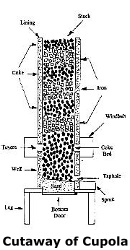
|
 Charcoal Furnace detailed in book.
Charcoal Furnace detailed in book.
|
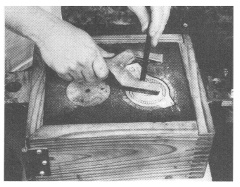
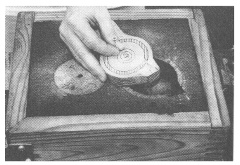
|
Volume 1 covers the basics as well as including detailed plans for a charcoal melting furnace.
There are many technical charts photos and illustrations.
Many of the illustrations are from earlier works on foundry practice and many are original.
|
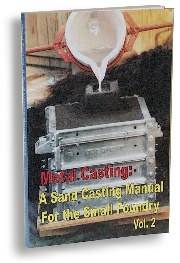
|
Volume 2:
The book covers:
- Solidification of Metals
- Aluminium Alloys
- Copper, brass and Bronze Alloys
- Metallurgy of Iron
- Gating Systems
- Risers and Feeding Castings
- Pattern making details
- Projects
- Automotive castings and the Ford flathead V-8
- Miscellaneous
-
|
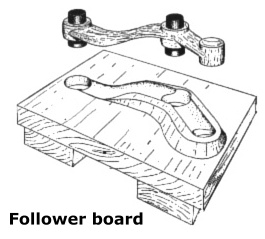
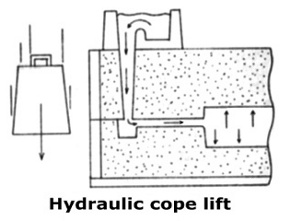 Volume 2 gets into more sophisticated problems and technical details.
However, many of these are important and although they can be ignored in some cases this is critical information for anyone that is going to do any significant casting.
Items like follower boards (illustrated above) are very common for all but the simplest shapes.
Volume 2 gets into more sophisticated problems and technical details.
However, many of these are important and although they can be ignored in some cases this is critical information for anyone that is going to do any significant casting.
Items like follower boards (illustrated above) are very common for all but the simplest shapes.
Another important issue is cope float (illustration above).
This occurs when the part has a large surface area and the sand above the casting weighs less than the hydraulic pressure.
I have had commercial foundries miss this important fact and try to pawn off castings with excessive flash and curved surfaces due to cope float.
Reviewers Note:
In this area you cannot have enough books with examples and problem solving.
Pattern and mold making can be simple in some cases but can be very complex in others.
Many solutions to mold making problems have been very imaginative and you can learn a LOT from what has been published here and in other books.
Making patterns and hand molding with loose patterns was one of the last great arts that was learned by experience and being a Journeyman working in and with a variety of foundries.
It was also one of those arts that little was published about until the late 20th century.
There were very basic examples given in many metalworking and engineering references but many details of the art were largely "trade secrets".
This is also one of those fields were the probability of failure is greater than success.
One must learn from experience or the experiance of others.
There have also been a LOT of changes in the foundry industry.
In the US the EPA has shut down many small foundries and pressure from imports has also has a great effect.
Although the techniques in these books have been the standard for hundreds of years do not expect to take your personally made patterns to a commercial foundry to be cast.
A VERY few foundries still deal with loose patterns and low quantities.
Although the basics still apply the majority of foundries have strict pattern requirements and will only deal with their own or known pattern makers.
The new methods include mold boxes with integral pattern halves that make the mold pieces separately using resin bonded sand.
A far cry from the loose pattern and cope and drag flasks.
The problems with getting castings made commericaly are probably why there has been a great deal of interest in the DIY foundry.
|
|
Published by:
Stephen D. Chastain
Jacksonville, FL
Distributed by:
ArtisanIdeas.com
Price 19.95 each
ISBN 0-9702203-2-4 Volume 1
ISBN 0-9702203-3-2 Volume 2
|
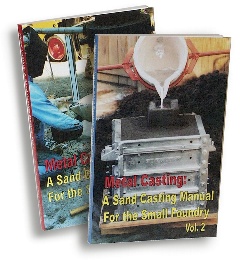







 Volume 2 gets into more sophisticated problems and technical details.
However, many of these are important and although they can be ignored in some cases this is critical information for anyone that is going to do any significant casting.
Items like follower boards (illustrated above) are very common for all but the simplest shapes.
Volume 2 gets into more sophisticated problems and technical details.
However, many of these are important and although they can be ignored in some cases this is critical information for anyone that is going to do any significant casting.
Items like follower boards (illustrated above) are very common for all but the simplest shapes.
